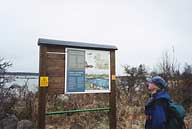Björkö archipelago
Björkö archipelago is located at the narrowest
point of the Kvarken region, which is why this area has played
an important role in transports. In the old days, Björkö
residents were often engaged to deliver people and the mail between
Sweden and Finland. The biggest islands - Lappören, Slåttskär
and Rönnskär - have been important for the villagers
as haying fields and pastures, as well as for wood, fishing and
hunting. Plenty of traces of human activity can still be found:
remains of old barns, fences and fishing cottages. Sheep still
graze in summer on Slåttskär and on Långgrund
on the island of Björkö itself.
The traditional customs have also left their mark. On
the large islands expansive sparse birch forests have retained
their open structure thanks to grazing and thinning. Where animals
no longer graze, the spruce tree has rapidly spread in among the
birch trees and transformed the light open pastures into mixed
forest. These have later transformed into dark spruce forest.
The birch forests have an abundance of windfall and hollow
trees, which makes them valuable for the many plant and animal
species that need dead or rotting wood. Many unusual mushrooms
can be found here, as well as insects and birds, including the
white-backed woodpecker, which is an endangered species in Finland
because of the lack of appropriate feeding and nesting sites.
The small-scale varied topography also creates an abundance
of wetlands of various types: "flador" (pools connected
to the sea) and "glosjöar" (tidepools that only
have water in them when the sea washes in), which are inlets in
different stages of being cut off from the sea, as well as marshes,
mires and bogs. In contrast, here and there are tall barren cairns
and brush-covered heaths. The white-tailed eagle breeds in the
area and is often seen circling over islands, sometimes several
together.
|






